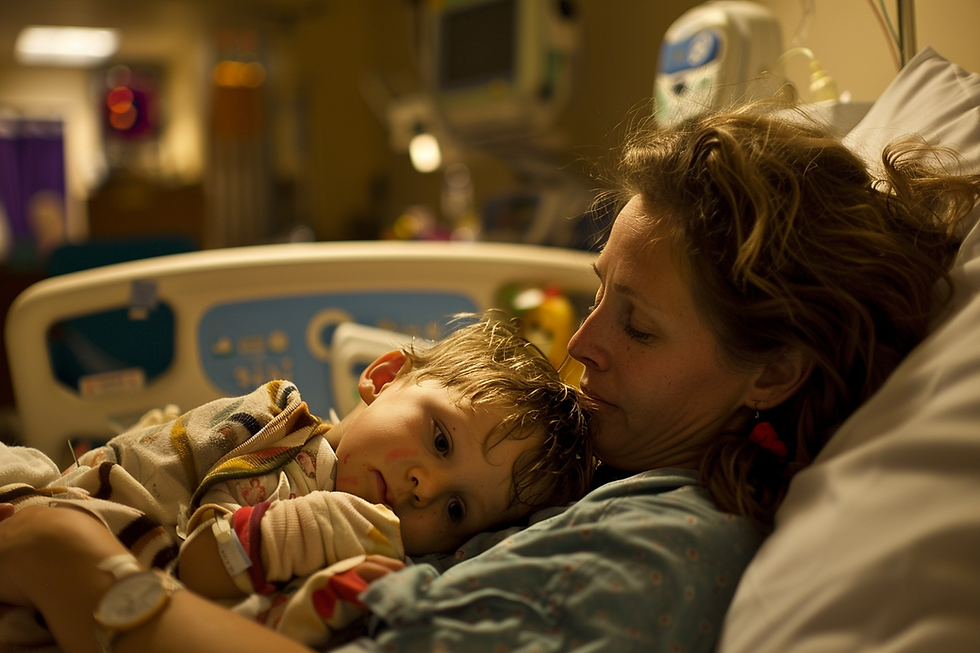Creating a Medical Comfort Kit for Your Child
- Caroline Monteiro
- Jun 5
- 4 min read
Updated: Jul 15
Essential items and activities to help your child feel safe and prepared.

When you’ve worked in enough hospitals, you start to notice the small things that matter.
A blanket that smells like home. A sticker chosen after a hard blood draw. A scribbled drawing taped beside the bed. These are the things that seem tiny to us—but they anchor a child when their world feels upside down.
That’s why I started encouraging families to make something simple, powerful, and personal: A Medical Comfort Kit.
Not a bag of distractions. Not a Pinterest-perfect project. But a small collection of items and tools that say to your child, “You are not alone. You have choices. You are safe.”
I Remember Jack
He was five, bright and clever, and had a rare metabolic condition that brought him into our unit every few months.
By the time I met him, he already knew the routine. He also knew what he hated: the scratchy gowns, the smell of antiseptic wipes, the cold stethoscopes.
His mum carried a small backpack with her. It didn’t look like much, but inside were Jack’s anchors:
A soft scarf from his grandma
A little laminated photo of his dog
A well-worn storybook they only read in hospital
And a “bravery button” he got to press after every procedure
It wasn’t magic. Jack still cried during IV insertions. He still clung to his mum at night.
But he also copied the nurses with his toy syringe. He laughed when his mum fumbled the storybook voices. And most importantly—he knew this was his space too.
That’s what a comfort kit does.It builds familiarity in unfamiliar places.It gives your child the emotional tools to say, “This is hard… but I’m not helpless.”
What Should Go In a Medical Comfort Kit?
There’s no one-size-fits-all. But here’s a framework I use when helping families build theirs:

1. Something That Feels Like Home
Think texture, scent, or sound. Something that brings the nervous system back to baseline.
A favorite soft toy or small pillow
A parent’s t-shirt to sleep with
A calming playlist or bedtime story recording
This isn’t just about comfort—it’s about regulation. When children feel overwhelmed, familiar sensory input helps bring their body and brain back into a safer state.
2. Something That Helps Them Understand
Information can calm fear. But for kids, it needs to be in their language.
A simple picture book about hospital visits
A doll or stuffed animal with bandages or IV lines
Visual cards that explain what to expect (you can make these together)
Children need preparation. Even if they don’t fully understand every medical term, they pick up on everything. When you give them language and images, they gain a sense of control.
3. Something That Lets Them Express
Medical environments often silence emotional expression. Everything’s focused on physical needs.
But fear, anger, boredom, grief—these need space too.
A small art kit (crayons, stickers, blank cards)
A “feeling thermometer” chart
A notebook to draw or “talk” to when words are too much
Expression is a release valve. Without it, everything builds up. With it, children process. They make sense of what’s happening—on their own terms.
4. Something to Help Cope in the Moment
These are the tools for during procedures, during waits, during scary transitions.
A fidget toy or sensory ball
A bubble wand for breathing practice
A small playlist of “brave songs”
You’re not trying to distract them from the experience—you’re giving them skills to get through it.
5. Something That Makes Them Feel Proud
Kids need to see their own strength. Not just hear us say it.
A sticker chart or “bravery badge” system
A small jar of affirmations or notes from loved ones
A Polaroid photo collection of “hospital wins”
Let your child see themselves as someone who can do hard things. Again and again.
Important Tip: Make It Together
This isn’t just your kit. It’s theirs.
So build it with them.
Go shopping together for the right pouch or backpack. Let them choose the fidget or favorite story. Ask, “What helps you feel brave?” even if they don’t have an answer right away.
When a child helps create their own comfort system, they’re learning one of the deepest lessons in resilience:
“I can be part of the solution. I’m not just a passenger in this experience.”
And When It’s Not Enough?
Even with the perfect kit, your child might still melt down. Refuse care. Beg to go home.
That’s normal.
This kit isn’t a cure—it’s a companion. It’s something to return to in hard moments. Something that reminds them: You’ve done this before. You can do it again. And you’re never doing it alone.
Final Thought
As a nurse and a mother, I’ve seen how even the smallest tool, like a teddy in a doctor’s coat, a whispered song before surgery can make all the difference.
Not because it takes the pain away. But because it tells the child,“This is your body. This is your experience. And you are allowed to feel safe in it.”
So build your child’s kit.
It won’t fix everything. But it will give them something real to hold onto. And sometimes, that’s more than enough.
Free Download: Your Medical Comfort Kit Checklist
Want a ready-to-use guide with item ideas, printable coping cards, and sample “brave” scripts?
👇 Download the free checklist below and start building your kit today.
SEO Keywords: comfort kit for child in hospital, how to prepare child for medical visits, pediatric hospital coping tools, items for child’s medical anxiety, trauma-informed support for kids, emotional support for children in hospitals



Comentários